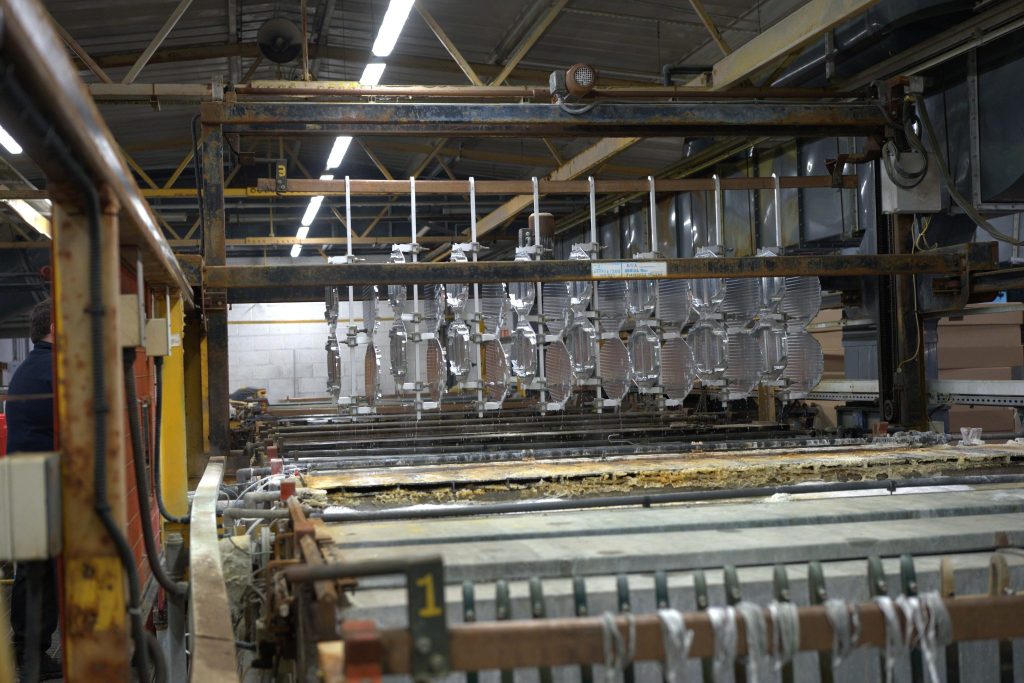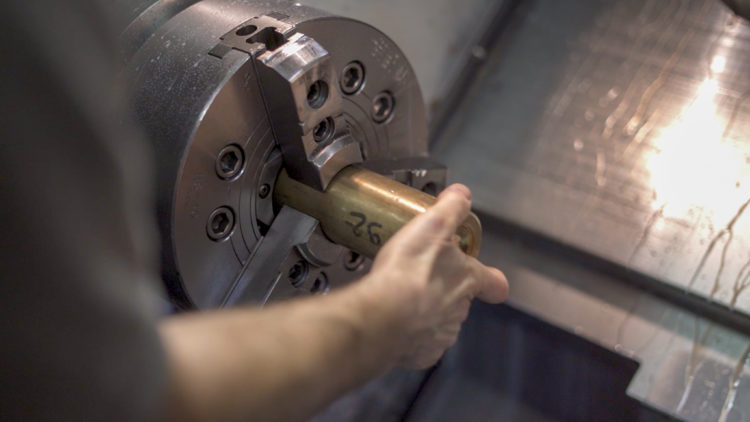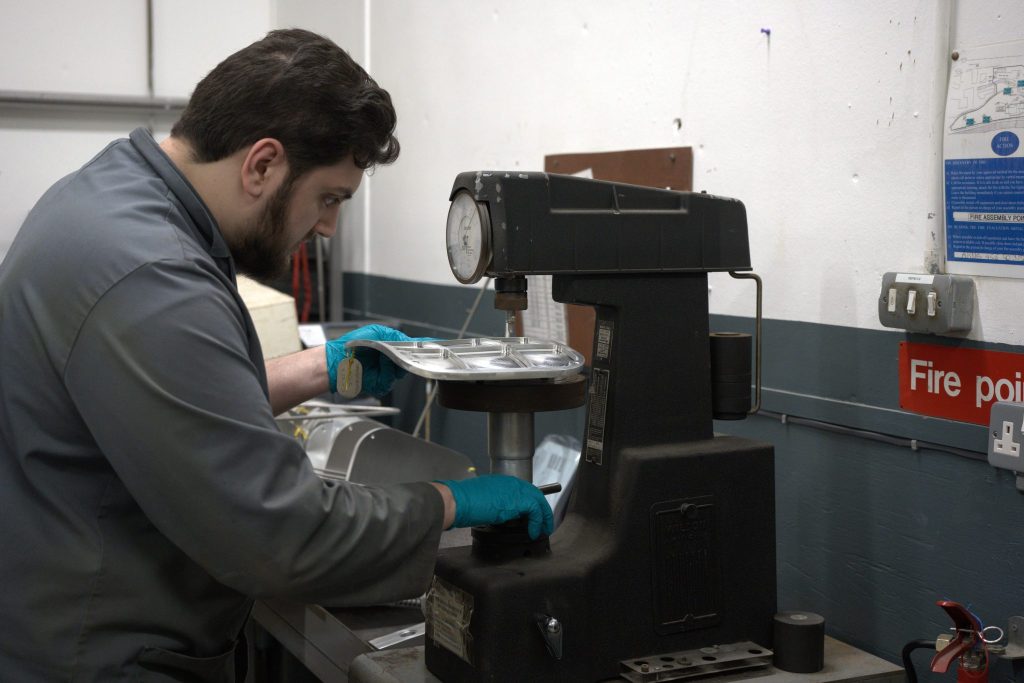Stanmar offers a complete managed solution to Surface Treatments and Special Processes by utilising the facilities of it’s sister company Nu-Pro. Using this facility enables us to prioritise work and offer further value enabling us to be a one stop shop for our customers.
Nu-Pro Special Processes offers a range of products and supporting services, such as NDT and Paint Facilities, which satisfies and exceeds customer expectations.
Nu-Pro provide employees with all relevant information and appropriate training in relation to quality and this includes complying with all relevant statutory requirements such as maintaining and developing management systems that meet the requirements of ISO9001/2000 and SAE AS9100.

Nu-Pro has large capacity in Copper Plating. Copper is a relatively soft and ductile metal. Because of its shiny orange colour it is widely used for decorative purposes. But it’s most outstanding property is its very high electrical conductivity, which is ten times higher than the conductivity of carbon steel. Therefore copper plating is a common coating in the electronics industry. Furthermore copper is used as a reliable masking for nitride hardening.
Copper pyrophosphate is widely used for plating tubular items which cannot be processed using the acid method, giving a deposit which is smooth and bright with excellent throwing power. It can be directly applied to metals such as brass, bronze and nickel silver.
Typical Applications of Copper Electroplating:
Electroless nickel plating is an auto-catalytic reaction, unlike electroplating, it is not necessary to pass an electric current through the solution to form a deposit.
Therefore it has several advantages:
Free from the need of the current to reach the area to be plated, nickel can be coated everywhere the solution touches the part. This means that it can plate the inside of tubes or holes which has design advantages over other electroplating processes.
Since it isn’t effected by high or low current density areas it plates an entirely even deposit over the whole part.
The electroless nickel coating is a nickel-phosphorous alloy, which is extremely hard, over 800 HV with post heat treatment, and therefore used for wear resistance. Depending on the requirements, there are different phosphorous contents available.
Typical Applications of Nickel Plating:
Nu-Pro Limited offers Zinc Nickel to Specification AMS 2417. The Zinc Nickel process offers a coating that is used in the protection of steel, copper, and brass alloys. Zinc Nickel is widely recognized as an environmentally safe alternative to cadmium and in certain applications, demonstrates equivalent, or better, corrosion properties compared to cadmium.
Zinc-Nickel functions as a “sacrificial coating”, corroding before the base material, and can also replace cadmium in a galvanic interaction where the coating is intended to minimize corrosion caused by dissimilar metals.
Typical Applications of Zinc-Nickel Electroplating:
Cadmium is robust and versatile. Cadmium has a silvery white metallic appearance with excellent corrosion resistance, which functions as a “sacrificial coating,” corroding before the substrate material. To enhance the corrosion protection of cadmium plating, chromate conversion coatings can be applied over the plated metal. Finishes available are:
Cadmium plating offers an exceptional bonding surface for adhesives, such as those used in aircraft manufacture, and is the preferred coating for salt-water environments. The coating is electropositive to iron and has a very low contact potential minimizes corrosion caused by dissimilar metals. Cadmium is a controlled substance and can only be used in specific applications.
In some applications, zinc-nickel plating may be an acceptable alternative to cadmium plating.
Typical Cadmium Applications:
Zinc Plating protects various base materials from corrosion. The zinc acts as a “sacrificial coating”, corroding before the base material which greatly extends part life. Zinc is an efficient coating, with a minimal environmental impact. Plated zinc is not recommended for equipment that is continually immersed in solutions, used in a vacuum (spaceflight) and it is also not typically recommended for aerospace applications.
Applications for Zinc Coatings:
Aluminium Anodising creates an aluminium oxide film on the surface of an aluminium substrate. The resulting film is electrically non-conductive, protects against corrosion and is resistant to wear. Aluminium anodising is used widely in aerospace, automotive, defence, and medical applications.
There are three different finishes available at Nu-Pro Limited.
Chromic acid anodising, The process is used predominantly for aerospace applications and produces a thin film coating which has an opaque appearance which is particularly suitable where minimal dimensional changes to components are permitted and also bonding prior to priming and painting.
Sulphuric acid anodising, the sulphuric acid process allows for a wide range of film thicknesses and gives excellent corrosion resistance which can also be enhanced by sealing in a chromate solution. The film can provide a range of surface textures with many different finishes. Matt, satin or a polished finish may be produced with this type of process. After sulphuric anodising Nu-Pro can offer a wide range of dyes to give a very attractive finish.
Hard sulphuric anodising, where a thick film is produced, that is highly abrasion resistant due to its surface hardness.
Colour anodising is also available to a wide spectrum of colours.
Due to the versatile properties of Chrome Plating it is widely used throughout different industries for decorative, as well as technical purposes.
Nu-Pro offers two different processes, which should be chosen depending on the requirements of the coating.
The extreme hardness of Hard Chrome Plating (over 1000 HV) is produced by the structure of the deposit. Furthermore the deposit has a very low coefficient of friction. These two properties together with the ability to apply very high thicknesses make Chrome Plating the perfect coating for wear resistance.
(A general thickness of 0.13mm (0.005”) is ample for most plating applications, but higher thicknesses of over 1mm is also possible)
It can be applied to stainless steels, cast irons, copper alloys, bronzes and nickel alloys. An excellent adhesion can be achieved on a variety of surfaces whether ground, finely turned or high polished.
Hard Chrome Plating is widely used in the aerospace industry as well as hydraulic industry, machine construction.
Chrome plating applied for a technical purpose with a very low thickness is called flash chrome plating
Silver is a, white, lustrous metal capable of taking a high polish.
Due to its extraordinary technical properties it is used in a wide range of applications.
Silver is the metal with the highest electrical conductivity of all metals and is therefore essential for light- and heavy current engineering.
In addition, silver is the most malleable metal after gold. Its outstanding anti-fretting properties makes it the perfect coating for high stress application such as slide bearings in the aerospace industry.
Nu-Pro offers two types of Silver plating which are specialised on the different properties of silver. Both types can be plated on various materials such as steel, stainless steel, copper brass and even aluminium.
Typical Applications of Silver Plating:
Passivation is performed to form a chemically inactive surface when exposed to air or other oxygen environments. The process is predominantly carried out where there is the potential for iron particles to be present on the surface of components as contamination after machining which if not removed would corrode. The company can also offer chromium free passivation.
Stainless steel passivation is performed to form a chemically inactive surface when exposed to air or other oxygen environments without changing the outward appearance of the component. The process is predominantly carried out where there is the potential for iron particles to be present on the surface of components as contamination after machining which if not removed would corrode and therefore weaken the part.
Typical Applications of Stainless Steel Passivation:


NDT Covers a wide group of testing processes and there are 5 main processes available at Nu-Pro Limited.
Magnetic Particle Inspection uses a magnetic field to locate surface and near-surface discontinuities in ferromagnetic materials. When very fine ferromagnetic particles are applied to the surface of the part and the magnetic field encounters a discontinuity the particles will be drawn into the discontinuity, producing a visible indication on the surface of the part.
Florescent Penetrant Inspection uses a very low viscosity fluorescent liquid which is applied to the surface of a part, it penetrates into defects on the surface. Once the excess penetrant is removed, the penetrant trapped in those defects will flow back out, creating an indication which can be seen under black light. Penetrant testing can be performed on magnetic and non-magnetic materials, but does not work well on porous materials.
Nital Etch Inspection is a test to determine if heat has been induced to a hardened steel component by machining, grinding, or other means, which will adversely affect the properties of the component. Under certain circumstances machining and grinding can introduce sufficient heat into a component to “burn” its surface. This is generally caused by local overheating and can produce undesirable changes in the metal’s properties. If an area is overheated, it will appear darker than the surrounding after etching.
Applications for NDT:
• Aerospace, used for detection of flaws in bushes gears
• General engineering, used for weld verification
Tin is a silver-white metal with a comparatively good corrosion resistance. Due to its low melting point it has a very good solderability which is the main reason why it is applied in a wide range of industries such as the aerospace- and the automotive industry. As a result of its good conductivity in combination with the good solderability it is also used in the electrical industry. Because of its non-toxic properties, it is a common coating for food processing items.
Tin can be plated on materials such as steel, stainless steel, copper and copper alloys. The standard thickness for Tin Plating is between 5 and 30 µm but higher thicknesses are available if required.
Typical Applications of Tin Plating:
Dry Film Lubricants, are high performance coatings made up of very fine particles of molybdenum disulphide, lubricating agents blended with binders and other additives. Once cured, it bonds to a surface as a solid film which reduces galling, seizing and fretting. Dry film lubricants improve the wear life of coated parts.
Dry film/solid film lubricants can operate at pressures above the load-bearing capacity of normal greases. They also collect less soil particulates. In some applications, the coating is self-burnishing this can lead to improved, performance over time. Some blends of dry film/solid film lubricants are also temperature and chemical resistant allowing for their use in harsh environments.
Typical Dry Film Lubrication Applications:
Our surface treatment facility provide painting operations. We offer wet paint coatings, pre- treatment, dry film lube and varnish.
Nu-Pro has fully qualified operators with many years of experience in all types of painting and related processes who can handle small intricate components as well as larger parts.
Currently the company has 4 separate wet paint areas carrying out a number of paint processes from the aerospace industry to commercial and domestic requirements.